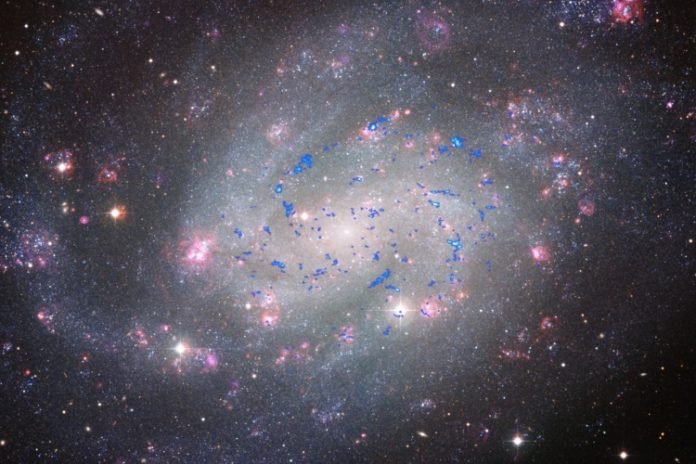
Spiral galaxies like our own Milky Way are studded with cold clouds of hydrogen gas and dust, like chocolate chips in a loaded Toll House cookie.
Astronomers have long focused on these so-called molecular clouds, suspecting that they are hotspots for star formation.
But are they?
After a thorough analysis of the molecular clouds in a nearby spiral galaxy, an international team of astronomers has found that, while star formation starts up rapidly in these clouds, the newly formed stars quickly disperse the cloud – in as little as a few million years – stopping further star formation.
So while star formation in cold molecular clouds is fast, it’s highly inefficient.
The findings by a collaboration led by Diederik Kruijssen from Heidelberg University will help astronomers understand where and when stars form in galaxies, which in turn determines how galaxies change over their lifetimes.
“The link between star formation and the evolution of galaxies is one of the main outstanding issues in astronomy,” said UC Berkeley postdoctoral fellow Anna McLeod, co-author of a paper published in Nature describing the analysis.
“How do stars form within the galactic context? What is their role in shaping the evolution of the galaxy they formed in?
And on what timescales does this all happen?”
The results come from use of a novel statistical approach that the team applied to data from the nearby spiral galaxy NGC 300, which is about 6 million light years from Earth in the direction of the constellation Sculptor.
The analysis showed that the intense radiation and stellar winds emitted by the young, massive stars forming in these clouds tamp down the formation of new generations of stars.
“The intense radiation from young stars disperses their parent molecular cloud by heating them and blowing hot bubbles of interstellar gas,” said co-author Mélanie Chevance, also from Heidelberg University.
“This way, only two to three percent of the mass in molecular clouds is actually converted into stars.”
“Molecular clouds in NGC300 live for about 10 million years, and take only about 1.5 million years to be destroyed, well before the most massive stars have reached the end of their lives and explode as supernovae,” added astrophysicist Kruijssen.
As a result, these molecular clouds are short-lived structures with rapid lifecycles, making galaxies “cosmic cauldrons” constantly changing their appearance.
The new analysis makes use of archival observational data in one single optical wavelength. McLeod is the principal investigator of a project to analyze a new, large observational dataset of NGC 300 that will allow the team to apply this novel statistical method to other optical wavelengths so as to capture star formation at many different evolutionary stages.
“We are now entering the era in which we can map many, many galaxies, near and far, at many different wavelengths simultaneously via so-called integral field spectroscopy,” McLeod said.
“We can then apply this new statistical method to these truly huge datasets and systematically understand star formation across the vast galaxy zoo that is out there.”
Written by Robert Sanders.
DOI: https://doi.org/10.1038/s41586-019-1194-3



